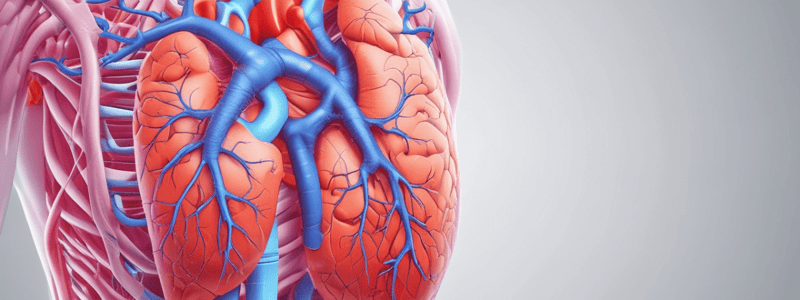Podcast
Questions and Answers
Which of the following accurately describes the path of pulmonary circulation?
Which of the following accurately describes the path of pulmonary circulation?
- Left ventricle → pulmonary artery → pulmonary capillaries → pulmonary veins → right atrium
- Right ventricle → pulmonary artery → pulmonary capillaries → pulmonary veins → left atrium (correct)
- Left atrium → pulmonary artery → pulmonary capillaries → pulmonary veins → right ventricle
- Right atrium → pulmonary vein → pulmonary capillaries → pulmonary artery → left ventricle
What is the primary process by which oxygen and carbon dioxide are exchanged between the alveolar air and the pulmonary blood?
What is the primary process by which oxygen and carbon dioxide are exchanged between the alveolar air and the pulmonary blood?
- Active transport
- Osmosis
- Diffusion (correct)
- Facilitated diffusion
What is the approximate total surface area of the respiratory membrane in a normal adult human male?
What is the approximate total surface area of the respiratory membrane in a normal adult human male?
- 700 m²
- 7000 m²
- 70 m² (correct)
- 7 m²
Which of the following is NOT a layer of the respiratory membrane?
Which of the following is NOT a layer of the respiratory membrane?
What is the approximate diameter of the pulmonary capillaries?
What is the approximate diameter of the pulmonary capillaries?
Which of the following factors can increase the thickness of the respiratory membrane?
Which of the following factors can increase the thickness of the respiratory membrane?
What is the approximate number of alveoli present in the two lungs?
What is the approximate number of alveoli present in the two lungs?
What is the approximate average diameter of an alveolus?
What is the approximate average diameter of an alveolus?
Which of the following statements about the rate of diffusion through the respiratory membrane is TRUE?
Which of the following statements about the rate of diffusion through the respiratory membrane is TRUE?
Flashcards are hidden until you start studying
Study Notes
Pulmonary Circulation
- The pathway of pulmonary circulation: right ventricle → pulmonary artery → right and left pulmonary arteries → pulmonary capillaries → pulmonary veins → left atrium
Diffusion of Oxygen and Carbon Dioxide
- Diffusion is the movement of gas molecules between the alveolar air and the pulmonary blood through the respiratory membrane
- The respiratory unit is composed of a respiratory bronchiole, alveolar ducts, atria, and alveoli
- There are approximately 300 million alveoli in the two lungs
- Each alveolus has an average diameter of about 0.2 μm
- The total surface area of the respiratory membrane is about 70 m2 in the normal adult human male
Respiratory Membrane
- The total quantity of blood in the capillaries of the lungs is 60-140 ml
- The diameter of the pulmonary capillaries is only about 5 micrometers
- The respiratory membrane consists of six layers:
- Thin fluid lining the alveolus and containing surfactant
- The alveolar epithelium
- A basement membrane
- An interstitial space between the alveolar epithelium and the capillary membrane
- A capillary basement membrane
- The capillary endothelial membrane
Factors Affecting Gas Diffusion
- The rate of diffusion through the membrane is inversely proportional to its thickness
- Factors that increase the thickness of the respiratory membrane:
- Edema fluid in the interstitial space of the membrane
- Fibrosis of the lungs, which can increase the thickness of the respiratory membrane
Studying That Suits You
Use AI to generate personalized quizzes and flashcards to suit your learning preferences.




